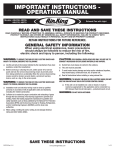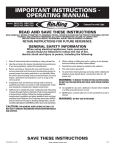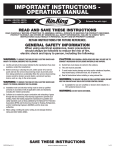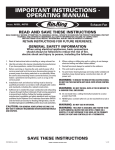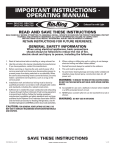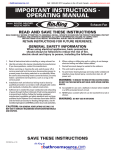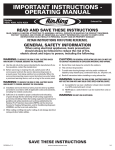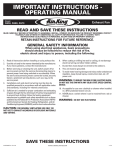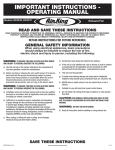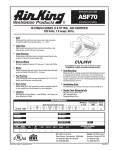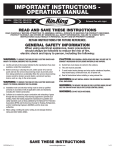Download Air King ASF50 Troubleshooting guide
Transcript
IMPORTANT INSTRUCTIONS OPERATING MANUAL Models: ASLC50, ASLC50FL, ASF50, ASLC70, ASF70 Exhaust Fan with Light READ AND SAVE THESE INSTRUCTIONS READ CAREFULLY BEFORE ATTEMPTING TO ASSEMBLE, INSTALL, OPERATE OR MAINTAIN THE PRODUCT DESCRIBED. PROTECT YOURSELF AND OTHERS BY OBSERVING ALL SAFETY INFORMATION. FAILURE TO COMPLY WITH INSTRUCTIONS COULD RESULT IN PERSONAL INJURY AND/OR PROPERTY DAMAGE! RETAIN INSTRUCTIONS FOR FUTURE REFERENCE. GENERAL SAFETY INFORMATION When using electrical appliances, basic precautions should always be followed to reduce the risk of fire, electric shock and injury to person, including the following: 1. Read all instructions before installing or using exhaust fan. 2. Use this unit only in the manner intended by the manufacturer. If you have questions, contact the manufacturer. 3. Before servicing or cleaning the unit, switch power off at service panel and lock the service disconnecting means to prevent power from being switched on accidentally. When the service disconnecting means cannot be locked, securely fasten a prominent warning device, such as a tag, to the service panel. 4. Installation work and electrical wiring must be done by qualified person(s) in accordance with all applicable codes and standards, including fire-related construction. 5. Sufficient air is needed for proper combustion and exhausting of gases through the flue (chimney) of fuel burning equipment to prevent back drafting. Follow the heating equipment manufacturer’s guideline and safety standards such as those published by the National Fire Protection Association (NFPA) and the American Society for Heating, Refrigeration, and Air Conditioning Engineers (ASHRAE), and the local code authorities. 6. When cutting or drilling into wall or ceiling, do not damage electrical wiring and other hidden utilities. 7. Ducted fans must always be vented to the outdoors. 8. This unit must be grounded. 9. To avoid motor bearing damage and noisy and/or unbalanced impellers, keep drywall spray, construction dust, etc. off power unit. WARNING: TO REDUCE THE RISK OF FIRE, ELECTRIC SHOCK, DO NOT USE THIS FAN WITH ANY SOLID-STATE SPEED CONTROL DEVICE. 10. Acceptable for use over a bathtub or shower when installed in a GFCI protected branch circuit. 11. NEVER place a switch where it can be reached from a tub or shower. WARNING: DO NOT USE IN KITCHENS CAUTION: FOR GENERAL VENTILATING USE ONLY. DO NOT USE TO EXHAUST HAZARDOUS OR EXPLOSIVE MATERIALS AND VAPORS. SAVE THESE INSTRUCTIONS 210572120 Rev. D 7-06 www.airkinglimited.com 1 of 12 INSTALLATION INSTRUCTIONS CAUTION: MAKE SURE POWER IS SWITCHED OFF AT SERVICE PANEL BEFORE STARTING INSTALLATION. Housing SECTION 1 Preparing the Exhaust Fan 1. Unpack fan from the carton and confirm that all pieces are present. In addition to the exhaust fan you should have: 1 - Grill with Light Lens 4 - Mounting Rails 1 - Damper Assembly (attached) 1 - Instruction/Safety Sheet 2. Remove the fan’s venturi assembly, which is secured in place with one screw through the venturi (Figure 1). This is a captive screw and will stay installed in the venturi. Keep the venturi assembly and the grill in the carton until needed so they do not get damaged or lost. Joist Mounting Rails Figure 3 2. Mounting Tab Installation: Using the gauge on the fan’s housing, line up housing so that it will be flush with the finished ceiling. Position the fan so that the tabs rest flat against the joist and secure with four nails (not provided) to ensure proper installation (Figure 4). 5/8" 1/2" 3/8" 1/4" Screw Figure 4 Figure 1 SECTION 3 3. Choose the location for your fan. To ensure the best air and sound performance, it is recommended that the length of ducting and the number of elbows be kept to a minimum, and that insulated hard ducting be used. Larger duct sizes will reduce noise and airflow restrictions. This fan will require at least 6" of clearance in the ceiling or wall, and will mount through drywall up to 3/4" thick. The fan can be mounted directly to the joist using the mounting tabs on the side of the housing or between 16" on center joists using the 4 provided mounting rails. 4. Select the most convenient electrical knockout and remove using a straight-blade screw driver Figure 2 (Figure 2). SECTION 2 1. Mounting Rail Installation: Set housing in position between the joist and trace an outline onto the ceiling material (Figure 5). Set housing aside and cut opening, being careful not to cut or damage any electrical or other hidden utilities. Install the rails on the housing and position the housing in the previously cut hole so that it is flush with the finished ceiling. Secure the ends of the rails to the joists (Figure 3). Figure 5 New Construction 1. Mounting Rail Installation: Install the rails on the housing and position the housing next to the joist. Using the gauge on the fan’s housing, line up housing so that it will be flush with the finished ceiling. Secure the ends of the rails with screws or nails (not included) to the joists and slide the housing into the final position (Figure 3). 210572120 Rev. D 7-06 Existing Construction 1. Mounting Tab Installation: Position housing against the joist and trace an outline of the housing onto the ceiling material (Figure 6). Set housing aside and cut opening, being careful not to cut or damage any electrical or other hidden utilities. Place housing next to the joist and insure that it is flush with the finished ceiling. Secure with four nails (not provided) to ensure proper installation (Figure 4). www.airkinglimited.com 2 of 12 Supply from house Ground White Hot (Black) Figure 8 Figure 6 SECTION 4 Ducting CAUTION: ALL DUCTING MUST COMPLY WITH LOCAL AND NATIONAL BUILDING CODES. 1. Connect the ducting to the fan’s duct collar (Figure 7). Secure in place using tape or screw clamp. Always duct the fan to the outside through a wall or roof cap. Figure 7 NOTE: If damper detaches from unit, reattach by snapping the collar back onto the unit. It is designed to only fit one way. Hot (Red) 2. Wiring Fan/Light together: Run wiring from an approved wall switch carrying the appropriate rating. One neutral (white), one ground (green or bare copper), and one hot (black lead connected to the switch). Secure the electrical wires to the housing with an approved electrical connector. Make sure you leave enough wiring in the box to make the connection to the fan’s receptacle. 2a. From where you have access to inside the fan’s junction box, connect the one white wire from the house to both the white wire from the fan’s light receptacle and the white wire from the fan’s exhaust receptacle. Connect the black wire from the wall switch to both the red wire from the fan’s light receptacle and the black wire from the fan’s exhaust receptacle. Connect the ground wire from the house to the green wire from the fan’s grounding screw (Figure 9). Use approved methods for all connections. Supply from house Ground White SECTION 5 Hot (Black) Wiring CAUTION: MAKE SURE POWER IS SWITCHED OFF AT SERVICE PANEL BEFORE STARTING INSTALLATION. CAUTION: ALL ELECTRICAL CONNECTIONS MUST BE MADE IN ACCORDANCE WITH LOCAL CODES, ORDINANCES, OR NATIONAL ELECTRICAL CODE. IF YOU ARE UNFAMILIAR WITH METHODS OF INSTALLING ELECTRICAL WIRING, SECURE THE SERVICES OF A QUALIFIED ELECTRICIAN. 1. Wiring Fan/Light Independently: Run wiring from an approved wall switch carrying the appropriate rating. One neutral (white), one ground (green or bare copper), and two hot (black lead connected to the switch). Secure the electrical wires to the housing with an approved electrical connector. Make sure you leave enough wiring in the box to make the connection to the fan’s receptacle. 1a. From where you have access to inside the fan’s junction box, connect the one white wire from the house to both the white wire from the fan’s light receptacle and the white wire from the fan’s exhaust receptacle. Connect the first black wire from the wall switch to the red wire from the fan’s light receptacle. Connect the second black wire from the house to the fan’s exhaust receptacle. Connect the ground wire from the house to the green wire from the fan’s grounding screw (Figure 8). Use approved methods for all connections. 210572120 Rev. D 7-06 Figure 9 Hot (Red) SECTION 6 Completing the Installation 1. Reinstall the fan’s venturi by holding it at approximately a 45 degree angle, hook the two tabs on the venturi into the slots on the housing and secure in place by tightening the venturi screw. Rotate the blower wheel by hand to ensure it spins freely. Now plug the fan motor into the receptacle (Figure 10). Figure 10 2. Install the grill/lens/light reflector, by first removing the lens from the grill (there are two tabs on either side that hold the lens in place). Then remove the acorn nut and the lock washer www.airkinglimited.com 3 of 12 which are installed on the reflector mounting bolt in the fan housing. Adjust the height of the reflector mounting bolt so that the grill will be tight up against the finished ceiling and less than 1/4" of the reflector mounting bolt protrudes through the reflector. Secure the reflector bolt’s position by tightening the factory installed nut against the motor clip (Figure 11). Motor Clip Mounting Bolt Nut Reflector Grill Lock Washer Acron Nut Figure 11 Tabs Lens CAUTION: FAILURE TO SECURE THE REFLECTOR BOLT MAY RESULT IN A RATTLING OR HUMMING NOISE. 3. After the reflector bolt is secure, raise the grill/reflector up into position, and plug the reflector into the appropriate receptacle. Secure the assembly to the reflector bolt using the acorn nut and lock washer. Install the appropriate bulb (not included) specific to your model: ASLC50/ASLC70: 100 watt maximum, type A19 medium base incandescent bulb. ASLC50FL: 13 watt maximum, 2 pin quad, compact flourescent bulb. ASF50/ASF70: 26 watt, triple 4 pin flourescent bulb. NEMA model: CFM26W/GX24q/27, 30, 35, 41 Sylvania model: CF26DT/E/IN/835, 841 Phillips model: PL-T 26W/30, 35, 41/4P GE model: F26BX/SPX30, 35, 41/A/4P Reinstall the lens into the grill (Figure 12). SECTION 7 Use and Care CAUTION: MAKE SURE POWER IS SWITCHED OFF AT SERVICE PANEL BEFORE SERVICING THE UNIT. 1. Cleaning the Grill: Remove grill and use a mild detergent, such as dishwashing liquid, and dry with a soft cloth. NEVER USE ANY ABRASIVE PADS OR SCOURING POWDERS. Completely dry grill before reinstalling. Refer to instructions in Section 6 Completing the Installation, to reinstall grill. 2. Cleaning the Fan Assembly: Unplug the motor cord and light cord from receptacles and loosen the venturi screw to remove the venturi from the unit. Wipe all parts with a dry cloth or gently vacuum the fan. NEVER IMMERSE ELECTRICAL PARTS IN WATER. Refer to instructions in Section 6 Completing the Installation, to reinstall venturi. CAUTION: ALLOW BULB TO COOL BEFORE REPLACING. 3. Changing the Light Bulb: Disconnect power to the unit. Remove the light lens by squeezing at the tabs and pulling down (Figure 13). Remove light bulb and refer to instructions in Section 6 Completing the Installation, to complete the light bulb change and installation of light lens. Tabs Figure 13 Figure 12 4. Restore power and test your installation. 210572120 Rev. D 7-06 www.airkinglimited.com 4 of 12 Troubleshooting Guide Trouble Probable Cause 1. Fan does not operate when the switch is on. Suggested Remedy 1a. A fuse may be blown or a circuit tripped. 1a. Replace fuse or reset circuit breaker. 1b. Connector plug from motor is not plugged in. 1b. Turn off power to unit. Remove Grill and plug motor into receptacle in housing. Restore power to unit. 1c. Wiring is not connected properly. 1c. Turn off power to unit. Check that all wires are connected. 2. Fan is operating, but air moves slower than normal. 2. 2. 3. Fan is operating louder than normal. 3a. Motor is loose. 3a. Turn off power to unit. Remove grill and check that all screws are fully tightened. Restore power to unit. 3b. Fan blade is hitting housing of unit. 3b. Call your dealer for service. Obstruction in the exhaust ducting. Check for any obstructions in the ducting. The most common are bird nests in the roof cap or wall cap where the fan exhausts to the outside. LIMITED WARRANTY All products manufactured by Air King Limited are warranted for one year from the date of purchase against defects in workmanship and/or material. In addition, all ventilating/exhaust fans, heaters, combination fan lights and/or heaters, and range hoods are guaranteed for five years from the date of purchase against defects in workmanship and/or material. This warranty does not cover any labor or shipping costs or the cost of replacement components as part of routine maintenance such as: range hood grease filters, charcoal filters or combination charcoal/grease filters; replacement light bulbs in range hoods or bathroom fan/light/bulb heater combinations. As well, any damage or failure caused by abuse, misuse, abnormal usage, faulty installation, or improper maintenance will not be covered by this warranty. In order to make a claim on this warranty, you must be the original consumer of the product. You will be required to present to Air King the original bill of sale showing: date of purchase, place of purchase and model purchased. Failure to meet these requirements will void your warranty. Air King will not be held responsible for any bodily injury or damages to personal property or real estate whether caused directly or indirectly by the product. Some states and provinces do not allow the exclusion or limitation of incidental or consequential damages and some states do not allow limitations on how long an implied warranty lasts, so these exclusions or limitations may not apply to you. This warranty gives you specific legal rights and you may have other rights which vary from state to state and province to province. FOR PARTS OR TECHNICAL ASSISTANCE Please call: 1-800-465-7300, MONDAY THROUGH FRIDAY, BETWEEN THE HOURS OF 8 AM AND 4:00 PM EST. PLEASE DO NOT RETURN PRODUCT TO PLACE OF PURCHASE. Reference the type and style of product (located on label inside of the product) when you call. For more information please visit our website: wwwairkinglimited.com Installer: _________________________________________________________ Installation Date:_________________________________________ Place of Purchase: _________________________________________________ Model Number: __________________________________________ 210572120 Rev. D 7-06 www.airkinglimited.com 5 of 12 REPLACEMENT PARTS DIAGRAM 2 1 3 4 20 19 16 6 5 7 18 17 8 15 9 28 25 22 27 22 10 14 11 12 21 26 13 23 24 # 1 2 3 4 5 6 7 8 9 10 11 12 13 14 15 210572120 Rev. D 7-06 Qty. 1 4 1 1 1 1 1 1 1 1 1 1 1 1 2 1 Description Replacement Part # Fan Housing 5S1201009 Mounting Rails 5S1299002 Collar 5S1201010 Damper 5S1201011 Polarized Receptacle 5S1999001 Goose Neck Wire Cover 5S1201004 #8 Screw 5S1999004 Polarized Nylon Receptacle 2P 5S1201012 #10 Machine Screw 5S1201013 ASLC Motor Clip 5S5201001 #10 Lock Washer 5S1999007 #10 Acorn Nut 5S1999008 Motor - ASLC50/ASLC50FL/ASF50 5S2201001 Motor - ASLC70/ASF70 5S2201003 Hex Nut 5S1999006 Impeller 5S1299001 # 16 17 18 19 20 21 22 23 24 25 26 27 28 Qty. 1 1 1 1 1 2 1 1 1 1 1 1 2 1 1 www.airkinglimited.com Description Motor Plate Captive Screw Scroll 14 ga Ground Wire #10 Ground Screw Palnut Light Reflector Grill Lens Lamp Holder - ASLC50/ASLC70 Ballast - ASLC50FL Ballast - ASF50/ASF70 Lamp Holder Nut - ASF50/ASF70 Lamp Holder - ASLC50FL Lamp Holder - ASF50/ASF70 Replacement Part # 5S1201014 5S1999005 5S1201006 5S1999003 5S1999002 5S1201015 5S2201004 5S1201016 5S1201017 5S1201018 5S1201022 5S1201023 5S1201035 5S1201024 5S1201025 6 of 12 INSTRUCTIONS IMPORTANTES – MANUEL D’OPÉRATION Modéles: Ventilateur combiner, comprend lumière et ventilation ASLC50, ASLC50FL, ASF50, ASLC70, ASF70 LIRE ET CONSERVER CES INSTRUCTIONS LIRE SOIGNEUSEMENT AVANT DE TENTER D’ASSEMBLER, INSTALLER, OPÉRER OU DE RÉPARER LE PRODUIT DÉCRIT. PROTÉGEZ VOUS-MÊME ET LES AUTRES EN OBSERVANT TOUTE L’INFORMATION DE SÉCURITÉ. FAILLIR À SE CONFORMER AUX INSTRUCTIONS PEUT RÉSULTER EN BLESSURE PERSONNELLE GRAVE ET/OU EN DOMMAGE À LA PROPRIÉTÉ. CONSERVER CES INSTRUCTIONS POUR RÉFÉRENCES FUTURES. INSTRUCTIONS GÉNÉRALES DE SÉCURITÉ Lors de l’utilisation d’appareils électriques, des précautions de base doivent toujours être suivies pour réduire les risques d’incendie, de choc électrique et de blessures corporelles, incluant ce qui suit: 1. Bien lire toutes les instructions avant d’installer ou d’utiliser le ventilateur d’évacuation. 2. Utiliser cette unité seulement de la manière pour laquelle le fabricant l’a conçu. Si vous aviez des questions, veuillez contacter le fabricant. 3. Avant d’effectuer un service ou de nettoyer l’unité, couper l’alimentation électrique dans le panneau de distribution et verrouiller le dispositif de déconnexion afin d’éviter que l’alimentation ne revienne accidentellement. Lorsque le dispositif ne peut être verrouillé, fixer solidement un avis d’avertissement, tel qu’une étiquette, au panneau de distribution. 4. Le travail d’installation et le câblage électrique doivent être effectués par une(des) personne(s) qualifiée(s) en conformité avec tous les codes et normes applicables, incluant la construction relative aux incendies. 5. De l’air en quantité suffisante est requis pour la bonne combustion et l’évacuation de gaz par le conduit (cheminée) provenant d’équipement de brûlage au combustible pour prévenir un refoulement. Suivre les directives du fabricant de l’équipement de chauffage et les normes de sécurité telles que celles publiées par la National Fire Protection Association (NFPA) et de la American Society for Heating, Refrigeration, and Air Conditioning Engineers (ASHRAE), et de celles des autorités locales du code. AVERTISSEMENT: POUR USAGE DE VENTILATION GÉNÉRALE EXCLUSIVEMENT. NE PAS UTILISER POUR ÉVACUER DU MATÉRIEL ET DES VAPEURS DANGEREUSES OU EXPLOSIVES. 6. Lors de coupe ou de perçage des murs et plafonds, ne pas endommager le filage électrique et autres utilités cachées. 7. Les ventilateurs avec conduits doivent toujours être évacués vers l’extérieur. 8. Cette unité doit être mise à la terre. 9. Pour éviter des dommages aux roulements des moteurs et/ou des hélices bruyantes ou déséquilibrées, empêcher la poussière de cloison sèche, poussière de construction, etc., d’atteindre l’unité de puissance. AVERTISSEMENT: POUR RÉDUIRE LES RISQUES D’INCENDIE OU DE CHOC ÉLECTRIQUE, NE PAS UTILISER CE VENTILATEUR AVEC UN RÉGULATEUR DE VITESSE ÉLECTRONIQUE. 10. Acceptable pour utilisation au-dessus d’une baignoire ou d’une douche lorsque installé dans un circuit protégé par un disjoncteur de fuite de terre. 11. NE JAMAIS placer un interrupteur à un endroit qui puisse être atteint de la baignoire ou de la douche. AVERTISSEMENT: NE PAS UTILISER DANS LES CUISINES CONSERVER CES INSTRUCTIONS 210572120 Rev. D 7-06 www.airkinglimited.com 7 of 12 INSTRUCTIONS D’INSTALLATION AVERTISSEMENT: VOUS ASSURER QUE L’ALIMENTATION EST COUPÉE AU PANNEAU DE SERVICE AVANT DE COMMENCER L’INSTALLATION. Cabinet SECTION 1 Préparation du Ventilateur d’évacuation Solive 1. Sortir le ventilateur de sa boite et confirmer que toutes les pièces sont présentes. En plus du ventilateur d’évacuation vous devriez avoir: 1 - Grille avec les Lentilles de l’éclairage 4 - Traverses de Montage 1 - Ensemble de clapet (attaché) 1 - Feuillet d’instructions / sécurité 2. Retirer l’ensemble venturi du ventilateur, lequel est fixé en place par une vis au travers du venturi (Figure 1). C’est une vis imperdable et elle demeurera installée dans le venturi. Garder l’ensemble venturi et la grille dans la boite jusqu’à ce que vous en ayez besoin pour qu’ils ne soient pas endommagés ou perdus. Traverses de Montage Figure 3 2. Installation des Onglets de Montage: à l’aide des guides sur le châssis du ventilateur, aligner le châssis pour qu’il soit à effleurement avec le plafond fini. Positionner le ventilateur pour que les onglets reposent à plat contre la solive et fixer en place à l’aide de quatre (4) clous (non-compris) pour assurer une bonne installation (Figure 4). 5/8" 1/2" 3/8" 1/4" Vis Figure 4 SECTION 3 Figure 1 Construction Existante 3. Choisir un emplacement pour votre ventilateur. Pour assurer la meilleure performance de l’air et sonore, il est recommandé que la longueur des conduits et que le nombre de coudes soit gardé au minimum, et que des conduits rigides isolés soient utilisés. Des plus grands formats de conduits réduiront le bruit et les restrictions au débit d’air. Ce ventilateur nécessite au moins 15,2cm (6po) de dégagement du mur ou du plafond et peut s’installer au travers de cloisons sèches d’épaisseur de 1,9cm (3/4po). Le ventilateur peut être monté directement sur la solive à l’aide des onglets de montage où entre les 40,6cm (16po) au centre des solives en utilisant les 4 traverses de montages fournies. 4. Sélectionner l’alvéole défonçable la mieux appropriée et l’enlever à l’aide d’un tournevis à lame plate (Figure 2). SECTION 2 Figure 2 Installation des Traverses de Montage: placer le châssis en position entre les solives et tracer un contour sur le matériau du plafond (Figure 5). Mettre le châssis de côté et découper l’ouverture, en prenant soin de ne pas couper ou endommager des câbles électriques dissimulés ou autres utilités. Installer les traverses sur le châssis et positionner le châssis dans le trou percé précédemment afin qu’il soit à effleurement avec le plafond fini. Fixer les extrémités des traverses aux solives (Figure 3). Figure 5 Nouvelle construction 1. Installation des Traverses de Montage: installer les traverses sur le châssis et positionner le châssis près de la solive. En utilisant le guide sur le châssis du ventilateur, aligner le châssis pour qu’il soit à effleurement avec le plafond fini. Fixer les extrémités des traverses avec des clous ou des vis (non-comprises) aux solives et glisser le châssis à sa position finale (Figure 3). 210572120 Rev. D 7-06 1. 2. Installation des Onglets de montage: positionner le châssis contre la solive et tracer un contour du châssis sur le matériau du plafond (Figure 6). Mettre le châssis de côté et découper l’ouverture, en prenant soin de ne pas couper de câble électrique dissimulé ou autre utilité. Placer le châssis près de la solive et vous assurer qu’il soit à effleurement avec le plafond fini. Fixer avec quatre (4) clous (non-compris) pour assurer une installation adéquate (Figure 4). www.airkinglimited.com 8 of 12 Alimentation provenant de la résidence d’évacuation. Raccorder le fil de mise à la terre de la maison au fil vert de la vis de mise à la terre du ventilateur (Figure 8). Utiliser des méthodes de raccordement approuvées pour toutes les connexions. Figure 6 Fil de Masse Blanc Fil Chaud (Noir) SECTION 4 Conduits 1. Raccorder le conduit au collet de conduit du ventilateur (Figure 7). Fixer en place à l’aide de ruban ou de serre-joint. Toujours évacuer le ventilateur vers l’extérieur au travers de chapeau mural ou de toit. Figure 7 REMARQUE: Si le clapet se détache de l’unité, le rattacher en cliquant le collet sur l’unité. Il est conçu pour ne s’assembler que d’une seule manière. SECTION 5 Câblage AVERTISSEMENT: VOUS ASSURER QUE L’ALIMENTATION EST COUPÉE AU PANNEAU DE SERVICE AVANT DE COMMENCER L’INSTALLATION. AVERTISSEMENT: TOUTES LES CONNEXIONS DOIVENT ÊTRE FAITES EN CONFORMITÉ AVEC LES CODES ÉLECTRIQUES LOCAUX OU NATIONAUX. SI VOUS N’ÊTES PAS FAMILIER AVEC LES MÉTHODES D’INSTALLATION DE CÂBLAGE ÉLECTRIQUE, RECOURREZ AUX SERVICES D’UN ÉLECTRICIEN QUALIFIÉ. Câblage du ventilateur/de la lumière sur des circuits indépendants: courir le câblage à partir d’un commutateur mural approuvé et de capacité appropriée. Un fil de neutre (blanc), un fil de mise à la terre (vert ou cuivre nu), et deux fils vivants (le fil noir raccordé à l’interrupteur). Fixer les câbles électriques au châssis à l’aide de connecteur électrique approuvé. Vous assurer que vous laissez suffisamment de câble dans la boîte pour permettre le raccordement au réceptacle du ventilateur. 1a. Par là où vous avez accès à l’intérieur de la boîte de jonction du ventilateur, raccorder un fil blanc de la maison aux deux fils blancs du réceptacle de la lumière du ventilateur et le fil blanc du réceptacle du ventilateur d’évacuation. Raccorder le premier fil noir provenant du commutateur mural au fil rouge du réceptacle de la lumière. Raccorder le second fil noir provenant de la maison vers le réceptacle du ventilateur 210572120 Rev. D 7-06 2. Câblage du ventilateur/de la lumière sur le même circuit: courir le câblage d’un commutateur mural approuvé et de capacité appropriée. Un neutre (blanc), un de mise à la terre (vert ou cuivre nu), et un vivant (fil noir raccordé à l’interrupteur mural). Fixer les câbles électriques au châssis avec un connecteur électrique approuvé. Vous assurer de laisser suffisamment de câble dans la boîte pour faire le raccordement au réceptacle du ventilateur. 2a. Par là où vous avez accès à l’intérieur de la boîte de jonction du ventilateur, raccorder un fil blanc provenant de la maison aux deux fils blancs du réceptacle de la lumière et le fil blanc du réceptacle du ventilateur d’évacuation. Raccorder le fil noir provenant du commutateur mural aux deux fils rouge du réceptacle de la lumière et au fil noir du réceptacle du ventilateur d’évacuation. Raccorder le fil de mise à la terre de la maison au fil vert de la vis de mise à la terre du ventilateur (Figure 9). Utiliser des méthodes de raccordement approuvées pour toutes les connexions. Alimentation provenant de la résidence AVERTISSEMENT: TOUS LES CONDUITS DOIVENT ÊTRE CONFORMES AUX CODES DU BÂTIMENT LOCAUX ET NATIONAUX. 1. Fil Chaud (Rouge) Figure 8 Fil de Masse Blanc Fil Chaud (Noir) Figure 9 Fil Chaud (Rouge) SECTION 6 Compléter l’installation 1. Réinstaller le venturi du ventilateur en le tenant à un angle d’environ 45 degrés, accrocher les deux onglets sur le venturi dans les fentes sur le cabinet et fixer en place en serrant les vis du venturi. Faire tourner la roue de la soufflante à la main pour s’assurer qu’elle tourne librement. Maintenant, connecter le moteur du ventilateur dans le réceptacle (Figure 10). Figure 10 www.airkinglimited.com 9 of 12 2. Installer la grille/ la lentille / le réflecteur de la lumière, en enlevant d’abord les lentilles de la grille (il y a deux onglets de chaque côté qui tiennent en place la lentille). Ensuite, enlever l’écrou borgne et la rondelle de sécurité qui sont installés sur le boulon de montage du réflecteur dans le châssis du ventilateur. Ajuster la hauteur du boulon de montage du réflecteur pour que la grille soit bien serrée contre le plafond fini et à moins de 0,6cm (1/4po) du boulon de montage du réflecteur en saillie au travers du réflecteur. Serrer en position le boulon en serrant l’écrou installé en usine contre le clip du moteur (Figure 11). Onglets EST COUPÉE AU PANNEAU DE SERVICE AVANT DE COMMENCER L’INSTALLATION. Lentilles AVERTISSEMENT: PERMETTRE À L’AMPOULE DE SE REFROIDIR AVANT DE LA REPLACER Réflecteur Écrou Borgne Figure 11 AVERTISSEMENT: VOUS ASSURER QUE L’ALIMENTATION Grille Boulon de Montage Rondelle de Sécurité Utilisation et entretien 1. Nettoyage de la grille: Retirer la grille et utiliser un détergent doux, tel que du liquide pour la vaisselle, puis sécher à l’aide d’un chiffon doux. NE JAMAIS UTILISER D’ABRASIF OU DE POUDRE À RÉCURER. Sécher complètement la grille avant de la réinstaller. Pour réinstaller la grille, vous référer à la Section 6 - Compléter l’installation. 2. Nettoyage de l’assemblage du ventilateur: débrancher le cordon d’alimentation du moteur et de la lumière des réceptacles et desserrer la vis du venturi pour enlever le venturi de l’unité. Nettoyer toutes les pièces avec un chiffon sec ou passer délicatement l’aspirateur. NE JAMAIS IMMERGER DES PIÈCES ÉLECTRIQUES DANS L’EAU. Vous référer aux instructions d’installation à la Section 6 Compléter l’installation pour réinstaller le venturi. Clip du Moteur Écrou SECTION 7 AVERTISSEMENT: UN MANQUEMENT À BIEN SERRER LE BOULON DU RÉFLECTEUR PEUT RÉSULTER EN UN BRUIT DE CRÉCELLEMENT ET DE RONRONNENT. 3. Après que le boulon du réflecteur est bien serré, mettre la grille / le réflecteur en position, et raccorder le réflecteur dans le réceptacle approprié. Fixer l’assemblage au boulon du réflecteur en utilisant l’écrou borgne et la rondelle de sécurité. Installer l’ampoule appropriée (non-compris) spécifique à votre modèle. ASLC50/ASLC70: ampoule incandescente à culot moyen de type A19, 100 watts maximum. ASLC50FL: ampoule de type fluorescent, à 2 tiges quad, compact, de 13 watts maximum. ASF50/ASF70: ampoule de type fluorescent, à 4 tiges triples, de 26 watts. Modèle NEMA: CFM26W/GX24q/27, 30, 35, 41 Modèle Sylvania: CF26DT/E/IN/835, 841 Modèle Phillips: PL-T 26W/30, 35, 41/4P Modèle GE: F26BX/SPX30, 35, 41/A/4P Réinstaller la lentille dans la grille (Figure 12). 3. Remplacement de l’ampoule: débrancher l’alimentation de l’unité. Enlever la lentille de la lumière en pressant sur les onglets et en la tirant vers le bas (Figure 13). Enlever l’ampoule et vous référer aux instructions de la Section 6 Compléter l’installation pour compléter le remplacement de l’ampoule et l’installation de lentille de la lumière. Onglets Figure 13 Figure 12 4. Restaurer l’alimentation et tester votre installation. 210572120 Rev. D 7-06 www.airkinglimited.com 10 of 12 Guide de dépannage Trouble Cause possible Solution suggérée 1. Le ventilateur ne fonctionne pas lorsque l’interrupteur est à la position en marche. 1a. Un fusible peut être grillé ou un disjoncteur peut être décle.nché. 1a. Remplacer le fusible ou réinitialiser le disjoncteur. 1b. La fiche de raccord du moteur n’est pas connectée. 1b. Couper l’alimentation à l’unité. Retirer la grille et brancher le moteur dans le réceptacle dans le cabinet. Remettre l’alimentation sur l’unité. 1c. Le câblage n’est pas raccordé correctement. 1c. Couper l’alimentation de l’unité. Vérifier que tous les fils sont raccordés. 2. Le ventilateur fonctionne, mais l’air circule plus lentement que la normale. 2. 2. 3. Le ventilateur fonctionne de manière plus bruyante que la normale. 3a. Le moteur est lâche. 3a. Couper l’alimentation à l’unité. Retirer la grille et vérifier que toutes les vis sont complètement serrées. Remettre l’alimentation sur l’unité. 3b. L’hélice du ventilateur frotte contre le cabinet de l’unité. 3b. Appeler votre marchand pour un service. Obstruction dans les conduits d’évacuation. Vérifier pour toute obstruction dans les conduits. Les plus courantes sont des nids d’oiseau dans le chapeau de toit ou mural là où le ventilateur s’évacue vers l’extérieur. GARANTIE LIMITÉE Tous les produits fabriqués par Air King Limited sont garantis pour un an à partir de la date d’achat contre les défauts de main d’œuvre et/ou de matériel. De plus, tous les ventilateurs / évacuateurs, chaufferettes, combinés ventilateur/ lumière et/ou les chaufferettes et les hottes de cuisine sont garantis pour cinq années à partir de la date d’achat contre les défauts de main d’œuvre et/ou de matériel. Cette garantie ne couvre pas de coûts de transport ou de main d’œuvre ou le coût de remplacement de composantes faisant partie d’entretien de routine tels que : Filtres à graisse des hottes de cuisine, filtres au charbon ou combiné filtre à graisse/ charbon ; ampoules électriques de remplacement dans les hottes de cuisine ou les combinés ventilateur/ lumière/ chaufferette pour salle de bain. Aussi, tout dommage ou défaillance causé par un abus, une mauvaise utilisation, une installation fautive ou un entretien incorrect ne sera pas couvert par cette garantie. De manière à effectuer une réclamation sous cette garantie, vous devez être l’acheteur original du produit. Il vous sera exigé de présenter la facture d’achat originale à Air King, qui démontrera : La date d’achat, l’endroit de l’achat et le modèle acheté. Le manquement à rencontrer ces exigences annulera votre garantie. Air King ne sera pas tenu responsable de quelque blessure corporelle ou dommage à la propriété ou à l’immeuble que ce soit causé directement ou indirectement par le produit. Certains États ne permettent pas de limitation sur la durée de la garantie implicite, ou l’exclusion ou la limitation de dommages indirects ou accessoires, ainsi, ces limitations et exclusions peuvent ne pas s’appliquer à vous. Cette garantie vous donne des droits légaux spécifiques et vous pouvez aussi avoir des droits qui varient d’un État à l’autre et d’une province à l’autre. POUR DES PIÈCES OU DE L’ASSISTANCE TECHNIQUE Veuillez appeler au 1-800-465-7300, DU LUNDI AU VENDREDI ENTRE 8:00 HRE ET 16:00 HRE HNE. VEUILLEZ NE PAS RETOURNER CE PRODUIT À L’ENDROIT DE L’ACHAT D’ORIGINE. Référencer le type et le style du produit (localisé sur l’étiquette à l’intérieur du produit) lorsque vous appelez. Pour plus d’information, veuillez visiter le site Web de Air King au www.airkinglimited.com Installateur: ______________________________________________________ Date d’installation: _______________________________________ Endroit de l’achat: _________________________________________________ Numéro de modèle:_______________________________________ 210572120 Rev. D 7-06 www.airkinglimited.com 11 of 12 DIAGRAMME DES PIÈCES DE REMPLACEMENT 2 1 3 4 20 19 16 6 5 7 18 17 8 15 9 28 25 22 27 22 10 14 11 12 21 26 13 23 24 # 1 2 3 4 5 6 7 8 9 10 11 12 13 14 15 Qty. 1 4 1 1 1 1 1 1 1 1 1 1 1 1 2 1 210572120 Rev. D 7-06 Description Cabinet du ventilateur Traverses de Montage Collet Clapet Réceptacle polarisé Couvre fil en col-de-cygne Vis #8 Réceptacle 2P Polarisé Vis à métal #10 Clip du moteur ASLC Rondelle de Sécurité #10 Écrou Borgne #10 Moteur - ASLC50/ASLC50FL/ASF50 Moteur - ASLC70/ASF70 Écrou hexagonal Hélice # de pièce de remplacement 5S1201009 5S1299002 5S1201010 5S1201011 5S1999001 5S1201004 5S1999004 5S1201012 5S1201013 5S5201001 5S1999007 5S1999008 5S2201001 5S2201003 5S1999006 5S1299001 # 16 17 18 19 20 21 22 23 24 25 26 27 28 Qty. 1 1 1 1 1 2 1 1 1 1 1 1 2 1 1 www.airkinglimited.com # de pièce Description de remplacement Plaque de Moteur 5S1201014 Vis imperdable 5S1999005 Volute 5S1201006 Fil de mise à la terre de calibre # 14 5S1999003 Vis #10 de mise à la terre 5S1999002 Écrou autofileteur 5S1201015 Réflecteur de la Lumière 5S2201004 Grille 5S1201016 Lentilles 5S1201017 Support de la Lumière - ASLC50/ASLC70 5S1201018 Ballast - ASLC50FL 5S1201022 Ballast - ASF50/ASF70 5S1201023 Écrou Support de la Lumière - ASF90/ASF120 5S1201035 Support de la Lumière - ASLC50FL 5S1201024 Support de la Lumière - ASF50/ASF70 5S1201025 12 of 12
This document in other languages
- français: Air King ASLC70













